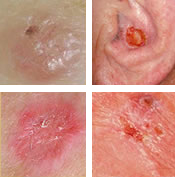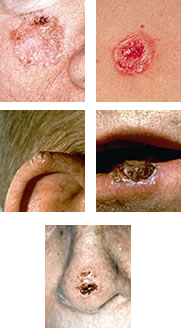Types of Cancer
Skin cancers are named for the type of cells that become cancerous.
The two most common types of skin cancer are basal cell cancer and squamous cell cancer. These cancers usually form on the head, face, neck, hands, or arms – areas exposed to the sun, but skin cancer can occur anywhere. A third type of cancer is melanoma. While relatively uncommon, it is important to watch for. If left untreated, melanoma can be fatal.
Basal Cell Carcinoma (BCC)
 Basal cell carcinoma is the most common form of skin cancer, with more than 1 million cases diagnosed in the US annually. BCC arises in the basal cells, which line the top layer of the epidermis or top layer of skin.
Basal cell carcinoma is the most common form of skin cancer, with more than 1 million cases diagnosed in the US annually. BCC arises in the basal cells, which line the top layer of the epidermis or top layer of skin.
- Slow growing, so highly treatable if caught early
- Grows like the roots of a tree, so can be deep if allowed to spread
- Rarely metastasizes, but tends to destroy surrounding tissue
- If allowed to grow, defect can be large and require multiple surgeries to correct
- If you have had one BCC, you are at greater risk for another
Squamous Cell Carcinoma (SCC)
 Squamous cell carcinoma is the second most common form of skin cancer with more than 700,000 cases diagnosed in the US annually. SCC arises in the squamous cells, which make up the skin's upper layers.
Squamous cell carcinoma is the second most common form of skin cancer with more than 700,000 cases diagnosed in the US annually. SCC arises in the squamous cells, which make up the skin's upper layers.
- Fast growing and a small percentage can metastasize to distant issues or organs
- Highly treatable, if caught early
- Appears as a persistent thick, rough, scaly patch that can bleed if bumped
- Sometimes appears as an open sore with a raised border and a scabbed surface over an elevated pebbly base
- Can appear like a wart
Melanoma
Melanoma is a rare form of skin cancer, but it is the most lethal. Melanoma is a malignant tumor that originates in melanocytes, the cells that produce the pigment melanin which colors our skin, hair and eyes.
- Melanoma is fast growing and metastasizes to other tissues and organs
- The majority of melanomas are black or brown
- Some melanomas are skin-colored, pink, red, purple, blue or white
- Melanoma is highly curable if caught early, but spreads rapidly
There are four types of melanoma. Three types are in situ, meaning they occupy only the top layers of the skin, and one type is invasive from the start. The types include:
- Superficial spreading melanoma is by far the most common type, accounting for about 70 percent of all cases, and is the one most often seen in young people. It travels along the top layer of the skin for a fairly long time before penetrating more deeply. This type of melanoma begins with a flat or slightly raised discolored patch that has irregular borders and is somewhat geometrical in form. The color varies, and you may see areas of tan, brown, black, red, blue or white. It can occur in a previously benign mole and can be found almost anywhere on the body.
- Lentigo maligna is similar to the superficial spreading type because it also remains close to the skin surface for quite a while, and typically appears as a flat or mildly elevated patch with mottled tan, brown or dark brown discoloration. This type of in situ melanoma is found most often in sun exposed parts on elderly patients.
- Acral lentiginous melanoma also spreads superficially before penetrating more deeply. It is quite different from the others, however, as it usually appears as a black or brown discoloration under the nails or on the soles of the feet or palms of the hands. It is the most common melanoma in African-Americans and Asians, and the least common among Caucasians.
- Nodular melanoma is usually invasive at the time it is first diagnosed. The malignancy is recognized when it becomes a bump. It is usually black, but occasionally is blue, gray, white, brown, tan, red or skin tone. Nodular melanoma is seen on the trunk, legs and arms, mainly of elderly people, as well as on the scalp in men. It is the most aggressive of the melanomas, and is found in 10 to 15 percent of cases.
Pre-Cancers
Sometimes a lesion is biopsied and diagnosed as a pre-cancer. There are two common types of pre-cancers, and while they are not cancer, they may turn into cancer if not treated.
Actinic keratosis is a type of flat, scaly growth on the skin. It is most often found on areas exposed to the sun, especially the face and the backs of the hands. The growths may appear as rough red or brown patches on the skin, or as cracking or peeling of the lower lip that does not heal. Without treatment, a small number of these scaly growths may turn into squamous cell cancer.
Bowen's disease is another type of scaly or thickened patch on the skin that may turn into squamous cell skin cancer.





